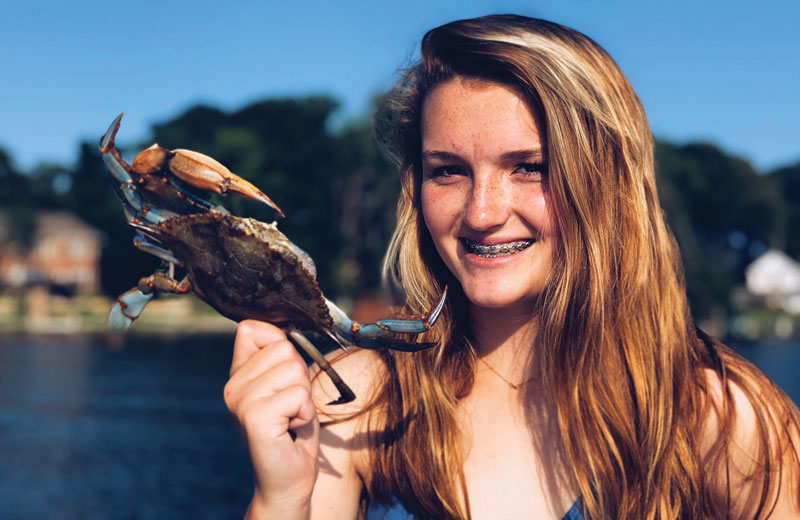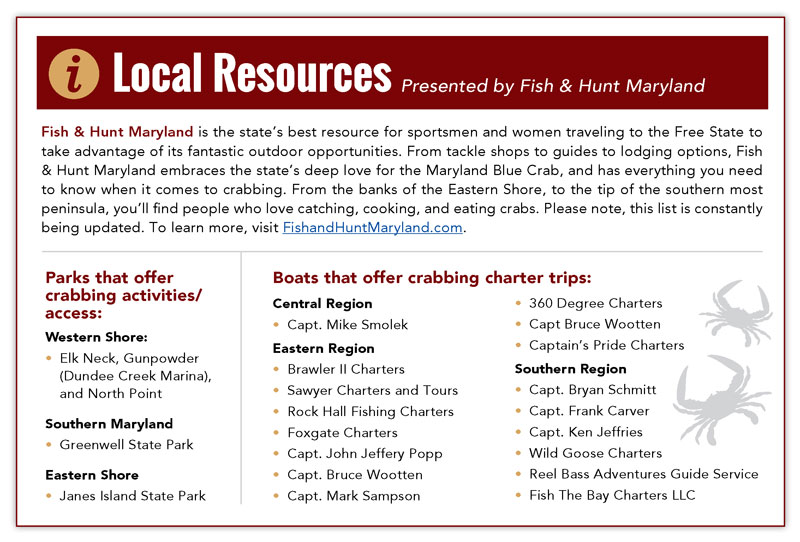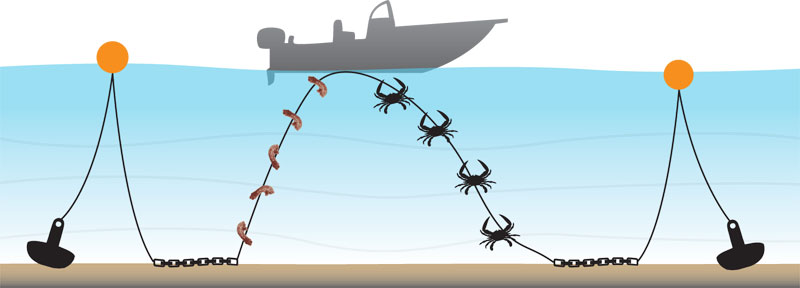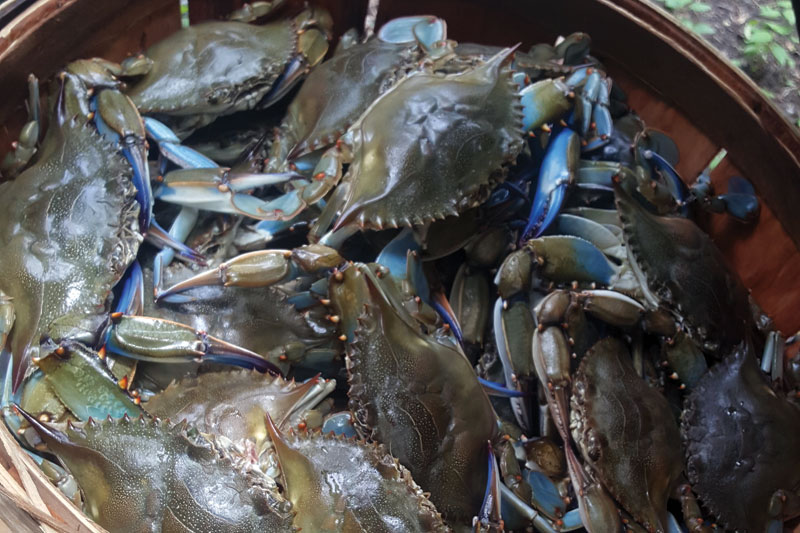Presented by Fish & Hunt Maryland
Recreational crabbing is right around the corner. Be sure you’re ready to load up the bushel basket with one of these three techniques, or by taking a crabbing charter.
The return of warm weather leads to one of the epic struggles of mankind, among we Chesapeake dwellers: should we go fishing for finfish this weekend, or should we go crabbing? More than one Bay-lover has practically gone mad as one side of his or her brain shouted “fish!” while the other cried out “crabs!” Yes, dear reader, we agree – it truly is a struggle to decide. Many of us will alternate days, choosing for the adrenaline rush of a tugging fish on the hook one weekend and opting to feed our addiction for a crustacean taste sensation the next. Others will resort to “frabbing,” and mix the two activities together at the same time.

However this internal battle plays out in your mind, one thing is for sure: few things in life can compare to the overwhelming joy of unloading a bushel basket of crabs into the steam pot, dumping in spice by the shovel-load, and then deeply inhaling the ecstasy-inducing aroma of steaming crabs. (Note: those of you who are shaking your head in disagreement are welcome to move back to Ontario any time you like).
While it’s true that Maryland’s crabbing season officially began last month, for recreational crabbers it has yet to kick in. The three forms of crabbing available to us – hand-lining, snap-trapping, and trot-lining – require the crabs to move into relatively shallow waters. Just when can you go out and catch your own bushel basket of prime jimmies? The crabs begin moving around when the water hits the mid-50s, but most folks wait until the very end of May or the beginning of June to go crabbing, when there’s a solid bet for success.
Hand-Lining
The tradition of hand-lining (sometimes called chicken-necking) runs deep in Maryland communities. What local kid hasn’t spent time on a dock, inching kite string towards the surface with a net at the ready? And one of the reasons why hand-lining remains incredibly popular to this day is that it requires no license, virtually no equipment investment, and no special skills. All you need is a ball of string, a net, and crab bait. A pack of chicken necks is the norm, but the head of a fish you caught the other day works just fine, too.
Simply tie your bait onto the end of your string, drop it to the bottom from virtually any public pier or dock on the Bay or its tributaries, and wait. It’s that simple. Most crabbers will set out a half-dozen or so lines, and patrol the dock while eyeballing them one after the next. When a crab gets on the bait and yanks, the line will stretch out at an angle and you know it’s time to pull the bait up – as slowly as possible so the crab isn’t startled or scared off – until you can see it. Then with a sweep of the net you’re in business.
Hand-Lining Tip: Bring along some small fishing weights you can add to the line. You need to get down to the bottom, and if the bait floats up you won’t catch many crabs.

Snap-Trapping
Snap-traps, also called collapsible traps or jerk-traps, have sides that fall open when the trap rests on bottom but swing closed when you tug on the line. These are very popular for three reasons: first, they require no expertise to use (if you can pull on a line, you can operate a snap-trap); second, early in the season before the crabs have moved shallow you can use them in areas too deep for running a trot-line; and third, they can be moved around far more easily than a trot line when you’re having trouble locating the crabs.
Some snap-traps have a small cage or arms to secure the bait in the middle of the bottom panel, while in some other cases you may need to tie the bait down with string or use a zip-tie to hold it in place. You can set them from piers, bridges where fishing and crabbing are allowed, or from any boat. In fact, using snap-traps is a great way to catch a load of crabs when you rent a boat for the day, because you can easily carry them aboard and set them with anything from a skiff to a yacht.
As the names “snap-trap” and “jerk-trap” infer, when pulling one of these traps in you should apply tension as quickly as possible with an abrupt tug. This will swing the trap’s hinged sides closed as quickly as possible, and prevent the crab from scooting out. Don’t worry if the snap-trap doesn’t have a top (many don’t and some people prefer open tops because they can be stacked in a smaller area, making it possible to crab from a very small boat or a kayak). Crabs swim sideways and down when they’re scared, so they almost never get out of a snap-trap just as long as you keep pulling it up after drawing the sides closed.
How do you know when to pull up the traps? There’s no way to tell when a crab enters one, so most people just wait five or 10 minutes and then give a look-see. If you set out a dozen or more traps, it’s standard practice to casually move from one to the next checking them more or less nonstop.
Snap-Trap Tip: When using a large number of traps, stick with chicken necks for bait. They’re very tough, and if a crab enters a trap shortly after you drop it, it’ll have a lot of time to chew on the bait while you check all the other traps. Baits like old fish parts tend to get torn up and eaten much more quickly. For more details on how to catch crabs using this method, check out How to Go Crabbing with Pull Traps

Trot-Lining
If you’re after a full bushel basket, no technique is more effective than running a trot-line. Using one, however, takes skill, practice, and a significant gear investment (including a boat). It also takes a lot of bait and a lot of work to prepare. A standard 1200-foot trot-line will have a bait every five or six feet, which means you need to attach around 200 chicken-chunks every time you use it.
Along with the line you’ll need floats and anchors to set at either end. And you’ll also need to rig your boat with a “stick,” a U-shaped arm protruding out to the side. Once the line is set you pull up the float at one end, snag the line underneath it, drop it into the U on the stick, and motor slowly forward. Keep it slow and steady and as the boat creeps along, and the crabs won’t even notice the trot line is being pulled up from the bottom. As one person drives the boat another stands posted forward of the stick, net in hand, ready to scoop the crabs as they rise up from the depths.
Truth be told, if you’re not experienced at running a trot-line the best thing to do is go on a crabbing charter. These are quite common on the Bay, and you’ll not only see how the pros do it, you’ll likely go home with just as many crabs as you can stand to eat. Taking a charter also means you don’t have to do the baiting and un-baiting, you can be on a large and comfortable boat that holds the whole family, and you’re free to enjoy a relaxing day on the water with a lot less work involved as compared to doing it all on your own.
Trot-Line Tip: Lay the line over an underwater point to figure out the best depth, then adjust your line accordingly so more of it is in that hot depth range. Again, we’ve got to stress: running a trot line can be a bit complex and the best way to learn how to it’s done is to take a charter, before trying it on your own. For more crabbing advice, be sure to read 10 Trot-Lining Tips
As to deciding when you should sacrifice some of your treasured fishing time to go crabbing, we can’t help. That’s a personal decision that only you – and those two voices shouting back and forth inside your head – can make.
 Rules and Regs
Rules and Regs
Due to possible changes and complexities in the regulations, we recommend visiting eregulations.com/maryland/fishing/blue-crabs/ prior to crabbing. That said, the regs are fairly simple for hand-lining and you’ll be fine just as long as you don’t keep more than two dozen crabs (if you get a $10 crabbing license that goes up to a bushel), and you don’t keep any females or undersized crabs (April 1 through July 14, minimum size is five inches shell tip to shell tip; July 15 to December 15 minimum size is five and a quarter inches). The rules and regs for snap-traps and trot-lines are a bit more complex so again, we advise visiting the regulations website.
How to Steam Your Own Crabs, Baltimore Style – Or Not!
If you don’t have a bushel-sized steam pot or you don’t want to make a (very big) mess, you may prefer to leave the crab steaming to a restaurant. In that case, we suggest checking out some of the top-notch seafood spots detailed in the Visit Maryland Crab & Oyster Trail (visitmaryland.org). There are dozens of excellent eateries (along with several steamed crab carry-out options) detailed on the Trail – try ‘em all and decide for yourself who steams crabs up the best!

For the DIY Steamers
Liquid for steaming: One can of Natty Boh or similarly cheap beer, one can of apple cider vinegar, and one can of water.
Spice mix – J.O. Crab Seasoning, or Old Bay mix (for one bushel): two cups Old Bay, two cups Morton’s Kosher Salt, four tablespoons dried mustard, four tablespoons mustard seed, two tablespoon celery seed. (Editor’s note: Baltimorians will argue endlessly over which spice is best and may become overly emotional when challenged on this topic. It should be considered similar to discussing politics and/or religion when in polite company. Because it sort of is).
Bring the liquid to a rolling boil, and start piling in the crabs while making sure they don’t go into the pot upside-down. Every half-dozen or so, shovel in spice. No crab should go un-spiced and as a general rule of thumb, more spice is better. Period.*
When the pot is full, cover it and steam for exactly 22 minutes. Thou shalt not steam for 21 minutes, nor shall thou steam for 23 minutes. As the crabs steam, cover a table with several layers of newspaper. When the crabs are done, make a big pile in the middle of the table and attack.
*Baltimore natives caught rinsing the spice off their crabs shall be banished to PennsylTucky.